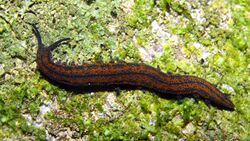Biology:Peripatoides
| Peripatoides | |
|---|---|

| |
| Scientific classification | |
| Domain: | Eukaryota |
| Kingdom: | Animalia |
| Phylum: | Onychophora |
| Family: | Peripatopsidae |
| Genus: | Peripatoides Pocock, 1894 |
| Species | |
|
See text
| |
Peripatoides is a genus of velvet worms in the family Peripatopsidae, whose species are found in New Zealand. Like all velvet worms, these animals are nocturnal predators that spit a sticky slime to trap their prey. Species of Peripatoides have 14, 15, or 16 pairs of legs.[1]
Taxonomy
The Peripatoides novaezealandiae species complex consists of at least five reproductively isolated species described in 1998, each of which has 15 pairs of legs.[2] These species (P. aurorbis, P. kawekaensis, P. morgani, and P. sympatrica) have no morphological characters that distinguish them although they are genetically differentiated.[3][2] Peripatoides novaezealandiae and the cryptic species were considered nomina dubia by de Sena Oliveira et al. (2012) because type localities were identified in the species descriptions rather than holotype specimens. In 2014 the New Zealand Department of Conservation recognised these species.[4] de Sena Oliveira (2023) later located the specimens used in the descriptions and as such no longer considered them nomina dubia.[5]
Species
The genus Peripatoides consists of the following species:[6]
- Peripatoides aurorbis Trewick, 1998
- Peripatoides indigo Ruhberg, 1985
- Peripatoides kawekaensis Trewick, 1998
- Peripatoides morgani Trewick, 1998
- Peripatoides novaezealandiae (Hutton, 1876)
- Peripatoides suteri Dendy, 1894
- Peripatoides sympatrica Trewick, 1998
Reproduction
This genus exhibits lecithotrophic ovoviviparity; that is, mothers in this genus produce and retain yolky eggs in their uteri.[7] The eggs are fertilized internally, and babies develop inside their mother until large enough to be born, in batches of 4–6, as colourless miniatures of the parents.[1] These live-bearing Peripatoides have dermal-haemocoelic sperm transfer – which means sperm dissolve holes in the skin of the female to enter the body (haemolymph) anywhere on the body wall of the female.[8]
References
- ↑ 1.0 1.1 Trewick, Steven (2019). Wild Life New Zealand. New Zealand: Hand-in-Hand Press. ISBN 978-0-473-48320-3.
- ↑ 2.0 2.1 Trewick, Steven A. (1998). "Sympatric cryptic species in New Zealand Onychophora" (in en). Biological Journal of the Linnean Society 63 (3): 307–329. doi:10.1111/j.1095-8312.1998.tb01520.x. ISSN 0024-4066.
- ↑ Trewick, S. A. (2000). "Mitochondrial DNA sequences support allozyme evidence for cryptic radiation of New Zealand Peripatoides (Onychophora)" (in en). Molecular Ecology 9 (3): 269–281. doi:10.1046/j.1365-294x.2000.00873.x. ISSN 1365-294X. PMID 10736025.
- ↑ New Zealand peripatus/ngaokeoke : current knowledge, conservation and future research needs. New Zealand. Department of Conservation, New Zealand.. Department of Conservation, Ōtepoti/Dunedin Office. 2014. ISBN 9780478150094. OCLC 994631114.
- ↑ Oliveira, Ivo de Sena (2023-11-16). "An updated world checklist of velvet worms (Onychophora) with notes on nomenclature and status of names" (in en). ZooKeys (1184): 133–260. doi:10.3897/zookeys.1184.107286. ISSN 1313-2970. PMC 10680090. https://zookeys.pensoft.net/article/107286/.
- ↑ Oliveira, I. S.; Read, V. M. S. J.; Mayer, G. (2012). "A world checklist of Onychophora (velvet worms), with notes on nomenclature and status of names". ZooKeys (211): 1–70. doi:10.3897/zookeys.211.3463. PMID 22930648. PMC 3426840. https://zookeys.pensoft.net/articles.php?id=2951&display_type=list&element_type=8. Retrieved 16 July 2016.
- ↑ Mayer, Georg; Franke, Franziska Anni; Treffkorn, Sandra; Gross, Vladimir; de Sena Oliveira, Ivo (2015), Wanninger, Andreas, ed., "Onychophora" (in en), Evolutionary Developmental Biology of Invertebrates 3 (Vienna: Springer Vienna): pp. 53–98, doi:10.1007/978-3-7091-1865-8_4, ISBN 978-3-7091-1864-1, http://link.springer.com/10.1007/978-3-7091-1865-8_4, retrieved 2023-02-16
- ↑ Tutt, Karen; Daugherty, Charles H.; Gibbs, George W. (2002). "Differential life-history characteristics of male and female Peripatoides novaezealandiae (Onychophora: Peripatopsidae)" (in en). Journal of Zoology 258 (2): 257–267. doi:10.1017/S095283690200136X. ISSN 1469-7998.
Further reading
- New Zealand Department of Conservation (2014) New Zealand peripatus/ngaokeoke: Current knowledge, conservation and future research needs. Dunedin: Department of Conservation. ISBN:978-0-478-15009-4
- Trewick, S. A. (1998). "Sympatric cryptic species in New Zealand Onychophora". Biological Journal of the Linnean Society 63 (3): 307–329. doi:10.1111/j.1095-8312.1998.tb01520.x.
- Trewick, S. A. (2000). "Mitochondrial DNA sequences support allozyme evidence for cryptic radiation of New Zealand Peripatoides". Molecular Ecology 9 (3): 269–281. doi:10.1046/j.1365-294x.2000.00873.x. PMID 10736025.
External links
Wikidata ☰ Q2808611 entry
 |

